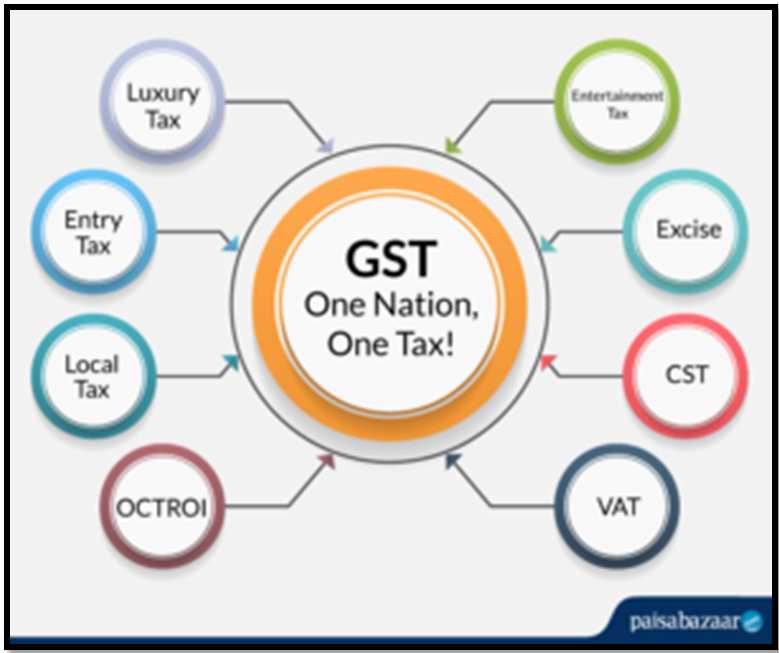FOR A FRESH START – THE GST COUNCIL
SYLLABUS:
GS 2:
- Functions and responsibilities of the Union and the States, issues and challenges pertaining to the federal structure, devolution of powers and finances up to local levels and challenges therein.
Focus:
- The GST Council must not lose sight of broader reforms. The Goods and Services Tax (GST) Council was convened last week for the first time in nearly nine months.
Source: POLICYBAZAR
What is the Current Framework of the GST System?
- About GST:
- The Goods and Services Tax (GST) is a value-added tax levied on most goods and services sold for domestic consumption.
- The GST is paid by consumers, but it is remitted to the government by the businesses selling the goods and services.
- It is essentially a consumption tax and is levied at the final consumption point.
- It was introduced through the 101st Constitution Amendment Act, 2016.
- It has subsumed indirect taxes like excise duty, Value Added Tax (VAT), service tax, luxury tax etc.
- The Goods and Services Tax (GST) is a value-added tax levied on most goods and services sold for domestic consumption.
- Existing Tax Structure:
- Central GST (CGST) covers Excise duty, Service tax etc.
- State GST (SGST) covers Value Added Tax (VAT), luxury tax etc.
- Integrated GST (IGST) covers inter-state trade.
- IGST is not a tax but a system to coordinate state and union taxes.
- There are four major GST slabs:
- 5%, 12%, 18% and 28%.
- Some demerit and luxury goods, which are in the 28% bracket, attract additional levy of cesses, the proceeds of which go to a separate fund meant to compensate states for revenue shortfall and repayment of compensation related loans.
A Fresh Start
- The Goods and Services Tax (GST) Council reconvened after nearly nine months.
- Eleven new State Ministers joined the Council alongside a recalibrated NDA government at the Centre.
- The Council’s agenda included clarifications, tweaks, forbearances, and procedural changes based on industry feedback.
- Despite a loaded agenda, the Council resolved to meet again in August to address pending items.
- Consensus was reached on multiple issues to ease taxpayer burdens, reduce litigation, and provide tax relief.
Key Decisions Made
- Hostel accommodation costing up to ₹20,000 a month was exempted from GST.
- Railway services availed by passengers were exempted from GST.
- A uniform 12% GST rate was approved for packing cartons, milk cans, and solar cookers.
- Interest and penalty on tax dues for the first three years of GST were waived, provided they are paid by March 2025.
- Pre-deposits for filing appeals were lowered, and a new form for correcting previous return errors was approved.
Broader Reforms and Simplifications
- The Council ended the anti-profiteering clause requiring firms to pass on tax cut gains to customers.
- Biometric-based Aadhaar authentication was mandated for all GST registrations in a phased manner.
- The aim was to ease the registration process and curb fraud through fake invoicing.
- The intent to simplify and declutter the seven-year-old indirect tax regime was evident.
- Ground-level impact of these moves may depend on subsequent fine print.
Future Plans
- The Council plans to revisit the 2021 plan to rationalize the multiple-rate GST structure.
- It aims to revive and expedite GST rate reforms.
- A road map to include excluded items such as petroleum and electricity into the GST net is to be incorporated.
- The Council’s approach emphasizes the need for broader tax system simplifications.
- The focus remains on streamlining and improving the overall effectiveness of the GST framework.
GST Council:
|
What are the Suggestions?
- Single GST Rate:
- GST rates should be the same on all goods as ‘progressive’ rates work best with direct taxes, not indirect taxes.
- When the GST was first announced, the National Council of Applied Economic Research (NCAER) estimated that it would lead to a 1.5% to 2% increment to the Gross Domestic Product (GDP).
- However, the estimate was based on the premise that all goods and services will be part of GST and there would be a single GST.
- Different GST rates allows a mindset of ‘prime control’ whereby GST rates are pegged higher for items considered ‘elitist’ and lower for items of mass consumption, resulting in differentiation and subjective interpretation and litigation.
- Tax rates need to go higher than the current average of 11.5% as opposed to the 17% revenue-neutral rate for GST officially estimated earlier.
- ‘Exemption-less’ Direct Tax Regime:
- The chairman called for an exemption-less direct tax regime with the argument that while tax evasion is illegal, tax avoidance, by using exemption clauses to reduce tax burden, is legitimate.
- More tax exemptions also lead to an increase in cases of tax complications.
- The artificial difference between corporate taxes and personal income taxes (PIT) should be removed.
- A lot of unincorporated businesses pay taxes under personal income taxes.
- The removal of differences using exemption-less direct tax system will also reduce administrative compliance.
- The chairman called for an exemption-less direct tax regime with the argument that while tax evasion is illegal, tax avoidance, by using exemption clauses to reduce tax burden, is legitimate.
Source:The Hindu
Mains Practice Question:
Discuss the recent decisions and broader reforms undertaken by the GST Council in its latest meeting. How do these decisions aim to simplify the GST regime and what are the potential impacts on taxpayers and the economy? Evaluate the importance of reviving the plan to rationalize the multiple-rate GST structure and the inclusion of excluded items like petroleum and electricity in the GST net.
Associated Articles:




